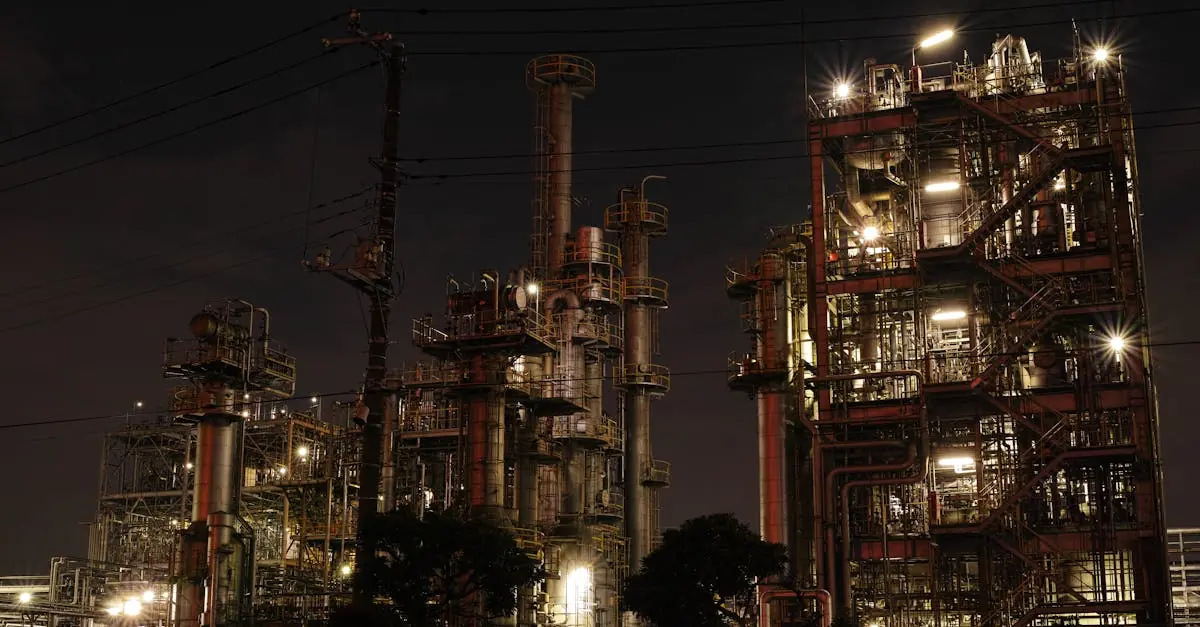As the world spins toward a greener future, the oil and gas industry finds itself at a crossroads. Will it adapt and thrive or cling to the past like a stubborn old car refusing to start? With electric vehicles zooming past and renewable energy sources popping up like mushrooms after rain, the industry faces some serious soul-searching.
Table of Contents
ToggleCurrent State of the Oil and Gas Industry
The oil and gas industry faces significant challenges as it navigates a landscape increasingly influenced by sustainability. Market dynamics shift rapidly, creating both obstacles and opportunities for adaptation.
Market Trends and Challenges
Evolving consumer preferences drive demand for cleaner energy sources, impacting traditional oil and gas models. Companies experience pressure to lower emissions and enhance environmental responsibility. The rise of electric vehicles contributes to diminishing oil demand in several key markets. Regulations aimed at carbon reduction add to operational complexities, requiring companies to invest in green technologies. Rising competition from renewable energy providers threatens market share, pushing oil and gas companies to innovate or risk obsolescence.
Technological Advancements
Innovative technologies emerge as vital solutions to meet current challenges. Automation in drilling processes boosts efficiency and reduces operational costs significantly. Advanced analytics enables better decision-making through improved data interpretation. Digital transformation sparks the deployment of artificial intelligence and machine learning to optimize production. Investments in carbon capture and storage technology highlight a commitment to sustainability and emissions reduction. As the industry adapts, collaboration with tech firms accelerates these advancements.
Environmental Impact
The oil and gas industry faces significant environmental challenges as it evolves toward sustainable practices. Climate considerations remain at the forefront of discussions concerning long-term viability and regulatory compliance.
Climate Change Considerations
Climate change drives the need for the oil and gas sector to reduce greenhouse gas emissions. The Intergovernmental Panel on Climate Change notes that fossil fuel combustion predominantly contributes to global warming, necessitating emission cutbacks. Embracing renewable energy technologies offers avenues to mitigate climate risks. Transitioning operations to minimize hydrocarbon extraction reduces risks associated with climate-induced events. Many companies now set actionable targets aligned with the Paris Agreement to lower their overall carbon footprint. Stakeholder pressure compels firms to level up reporting practices on environmental impacts, thus enhancing transparency.
Transition to Renewable Energy
The transition to renewable energy sources reshapes the oil and gas industry’s operational fabric. Investment in solar, wind, and geothermal energy technology opens pathways for sustainable practices. The Energy Information Administration highlights that renewable sources could account for over 30% of electricity generation by 2030. As consumer preference shifts toward cleaner options, companies pivot their strategies to accommodate this change. Integrating hybrid energy solutions enables firms to diversify portfolios while meeting regulatory standards. Partnerships with renewable energy firms amplify competitive advantages and stimulate innovation in energy production and consumption.
Economic Factors
Economic factors significantly influence the oil and gas industry. These dynamics shape market trends and impact operational decisions.
Global Demand and Supply Dynamics
Global demand for oil and gas continues to evolve. Many countries are transitioning to greener energy sources, impacting traditional oil and gas consumption patterns. The International Energy Agency reported a potential decline in oil demand due to increased electric vehicle adoption. Supply constraints also affect pricing, with geopolitical tensions periodically disrupting production. Balancing renewable investments and fossil fuel production is essential, as markets adjust to shifting consumer preferences. Increased production in regions such as the United States alters the global marketplace, affecting traditional oil-exporting nations.
Investment Trends in Oil and Gas
Investment trends highlight a crucial pivot within the oil and gas sector. More companies are allocating resources toward sustainable technologies and transitioning to renewable energy projects. According to BloombergNEF, global investment in renewable energy reached $281 billion in 2020. Traditional oil and gas firms are forging partnerships with technology companies to enhance efficiencies. This shift embodies a broader strategy to adapt to market pressures and comply with regulations. Additionally, shareholder demands for greener practices drive firms to rethink their investment portfolios. Reallocation of capital toward cleaner technologies emerges as a priority for future growth.
Innovations Shaping the Future
Innovative technologies are steering the oil and gas industry toward a more sustainable future. Companies are increasingly focused on digital transformation and alternative energy sources to adapt to changing market dynamics.
Digital Transformation
Automation enhances operational efficiency in drilling processes. Data analytics facilitate informed decision-making by interpreting vast data sets. Artificial intelligence and machine learning optimize production and resource allocation. Collaborations with technology firms amplify these advancements, as traditional oil and gas companies embrace a tech-driven approach. A report from McKinsey indicates that digital transformations can improve performance metrics by up to 20%. This evolution is crucial for maintaining competitiveness in an increasingly eco-conscious marketplace.
Alternative Energy Sources
Investment in alternative energy sources is gaining momentum. Emerging technologies like solar, wind, and geothermal energy are reshaping the industry’s operational strategies. The International Energy Agency reports that global investment in renewable energy reached approximately $281 billion in 2020. Partnerships with renewable energy firms stimulate innovation and diversify traditional portfolios. Adjusting to transitioning consumer preferences is essential for retaining market share, as the demand for cleaner energy alternatives continues to rise. These initiatives signify a pivotal shift toward sustainability within the sector.
Regulatory Landscape
The regulatory environment significantly influences the oil and gas industry as it transitions toward sustainability. Companies face increasing government policies aimed at reducing carbon emissions and promoting cleaner technologies. Compliance with local, state, and federal regulations is essential. Specific mandates, like emissions reduction targets, drive companies to innovate rapidly. The evolving landscape often requires substantial investment in new technologies to meet stringent standards efficiently.
Government Policies and Regulations
Government policies directly impact operational strategies within the industry. Regulatory frameworks encourage investments in low-emission technologies, while penalties for non-compliance can be severe. Hefty fines increase financial pressures on companies unable to adapt swiftly. Tools like cap-and-trade systems and strict emissions guidelines drive firms to overhaul practices and invest in greener alternatives. Enhanced oversight on environmental impact assessments also reinforces the importance of transparency in reporting.
International Agreements
International agreements play a pivotal role in shaping the oil and gas sector’s regulatory landscape. The Paris Agreement sets ambitious targets for carbon neutrality, influencing national policies worldwide. Companies must align their goals with international frameworks to remain competitive. Cooperation among nations fosters a shared commitment to climate action, prompting firms to adopt sustainable practices proactively. Adherence to global agreements not only ensures compliance but also enhances the industry’s reputation as it navigates its transformation.
The future of the oil and gas industry hinges on its ability to adapt to an ever-evolving landscape. As sustainability becomes a priority for consumers and regulators alike, companies must embrace innovative technologies and rethink their operational strategies. The shift toward renewable energy and electric vehicles is not just a trend; it’s a call to action for the industry to transform or face obsolescence.
Investment in cleaner technologies and collaboration with tech firms will be crucial for navigating this transition. By prioritizing sustainability and transparency, the oil and gas sector can not only meet regulatory demands but also align with the expectations of a more eco-conscious market. The path forward is challenging but filled with opportunities for those willing to innovate and adapt.




